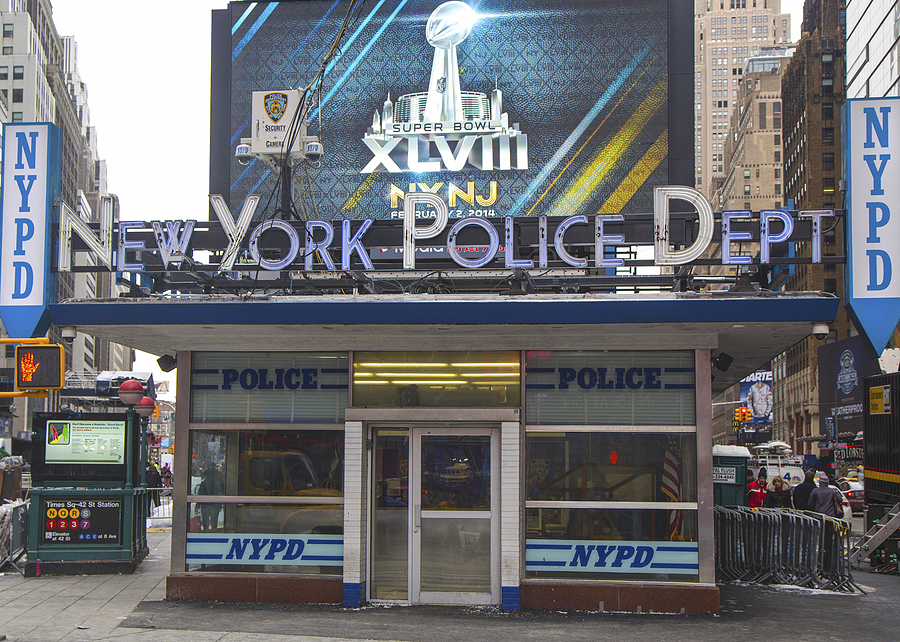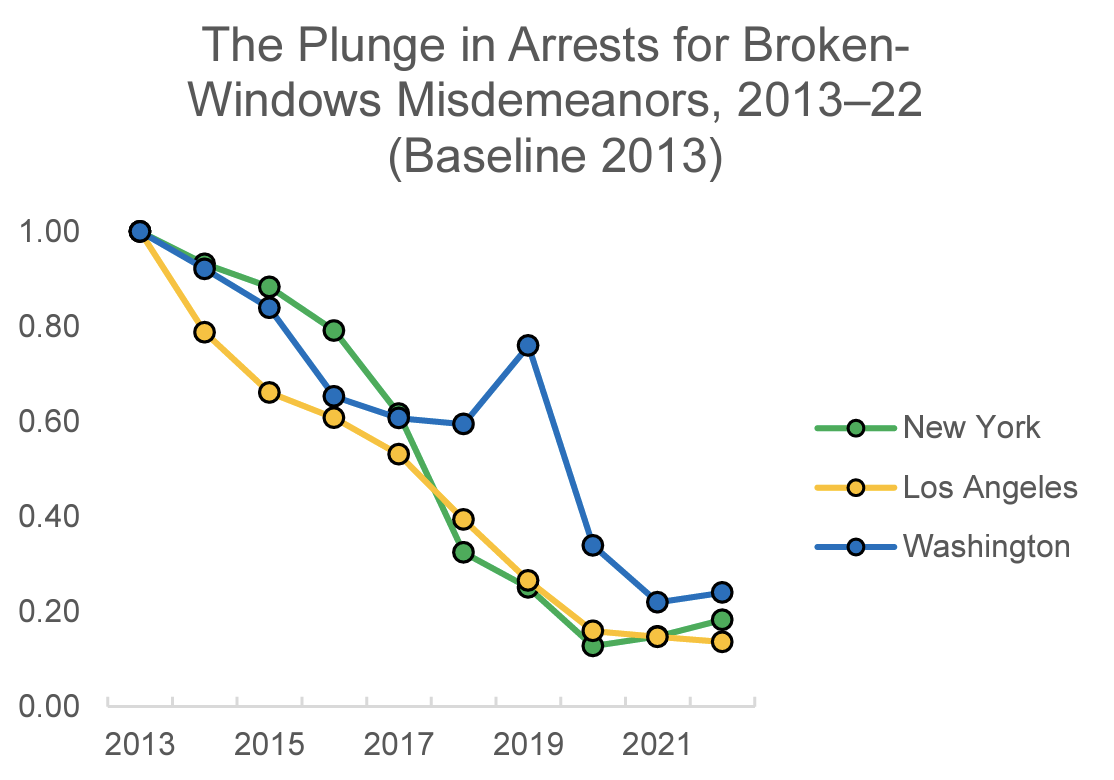
August 09, 2023

Source: Bigstock
Many people have strong opinions on what’s the best place to live: city, suburb, or country? Yet, personally, I’ve enjoyed every place I’ve lived and would like to see each kind thrive. Hence, I’ve been vocally critical about the American establishment letting our big cities decay into disorder during the Black Lives Matter era.
A new study by data maestro Charles Murray, coauthor of The Bell Curve, “The Collapse of Broken-Windows Policing in New York City, Los Angeles, and Washington, DC, 2013–22,” traces the roots of the 2020s surge in crime (the annual homicide rate in 2020–2022 has been 31 percent higher than in 2019) and car crashes (traffic fatalities are up 15 percent) to an abandonment during the last decade’s Great Awokening of the crime-fighting strategy that had been succeeding for several decades.
America let most of its big cities fall apart after WWII, first due to hugely widespread car ownership making suburban life more feasible, then due to liberals in the 1960s and 1970s letting urban crime run amok.
Some cities, such as Detroit and Gary, have never recovered. But over time, some more privileged places, most notably New York City, began to see law and order get the upper hand again.
The urban revival was due in part to conservative social scientists winning a war of ideas and data over the long-dominant liberal academics. In a famous 1982 Atlantic article, the political scientist James Q. Wilson and criminologist George Kelling noted:
Social psychologists and police officers tend to agree that if a window in a building is broken and is left unrepaired, all the rest of the windows will soon be broken. This is as true in nice neighborhoods as in rundown ones. Window-breaking does not necessarily occur on a large scale because some areas are inhabited by determined window-breakers whereas others are populated by window-lovers; rather, one un-repaired broken window is a signal that no one cares, and so breaking more windows costs nothing.
Wilson and Kelling likewise argued that the sight of people getting away with minor crimes with impunity—such as turnstile jumping, vandalism, vagrancy, lewd catcalling, suspicious loitering, and the like—encourages major crimes like robbery, rape, and murder.
This theory of broken windows was Wilson’s second big conceptual contribution to reducing crime. The first—incapacitation—has been forgotten because it’s embarrassing to remember just how inane liberal elites had gotten in their thinking about crime during the 1960s.
Because researchers couldn’t prove that prison reformed or deterred criminals, the conventional wisdom back then became: What was the point of sentencing crooks to prison at all? So, during the 1960s the number of people in prison declined even as crime grew.
But, as Wilson pointed out in the 1970s, somebody can’t be committing more street crimes if he’s in prison rather than out on the streets. At minimum, prison incapacitates criminals.
Granted, Wilson’s first big idea—that if Central Park muggers are in prison, then they can’t mug people in Central Park—doesn’t seem like a genius insight today. But it was, apparently, a blinding revelation in 1975.
Wilson concluded his book Thinking About Crime:
Wicked people exist. Nothing avails except to set them apart from innocent people. And many people, neither wicked nor innocent, but watchful, dissembling, and calculating of their opportunities, ponder our reaction to wickedness as a cue to what they might profitably do. We have trifled with the wicked, made sport of the innocent, and encouraged the calculators. Justice suffers, and so do we all.
Broken-windows policing targeted the watchful and calculating by showing them that this isn’t the kind of place that tolerates any of your criminal nonsense.
And we shouldn’t overlook some examples of political courage among urban leaders around the turn of the century. For example, when billionaire Michael Bloomberg took over as mayor of New York in 2002, murders were already way down from their peak during the crack wars a dozen years before. But he wasn’t satisfied and pushed policies that continually drove down the murder rate via point-of-use gun control.
Bloomberg was utterly without illusion about who commits murders, telling elites in Aspen:
Ninety-five percent of your murders—murderers and murder victims—fit one M.O. You can just take the description, Xerox it and pass it out to all the cops. They are male minorities, 16 to 25. That’s true in New York. That’s true in virtually every city. And that’s where the real crime is. You’ve got to get the guns out of the hands of the people that are getting killed.
President Donald Trump immediately replied:
“WOW, BLOOMBERG IS A TOTAL RACIST!”
But Trump later deleted this tweet and instead substituted that Bloomberg was short and bad at golf.
A forgotten example of good leadership was displayed by James Hahn, a one-term mayor of Los Angeles from 2001 to 2005. He defeated Antonio Villaraigosa’s Mexican-Jewish liberal coalition by assembling an unusual team of blacks and more conservative whites. But once in office, he chose to not offer LAPD’s well-meaning but inept black police chief another term in order to hire the most gifted police chief of his generation, Rudy Giuliani’s former police commissioner Bill Bratton. Black voters were outraged and deserted Hahn for Villaraigosa in the next election. But L.A. policing got better.
Due to people like Wilson, Bloomberg, and Hahn, in this century law and order made a comeback. Hence, urban living became more popular.
To live in a big city, you need policing. If you commute to work in an F-350, you can get by without much order. But if you save on money by commuting in a metal box, whether subway or bus, you really need to be confident that your fellow commuters with whom you are confined aren’t crazymen.
Therefore, even downtown Los Angeles, which is randomly placed twenty miles inland, got fashionable.
But that now seems like a long time ago.
The decline of cities in this decade is partly due to Covid making public transportation unpopular, and partly to work-from-home proving not as infeasible as was long assumed. Reporter Sam Quinones points to fentanyl and, perhaps, a different type of meth arriving in the big cities around 2015, leading many to go homeless in order to save on rent and spend more on drugs.
But a big reason is that elites decided that law and order was racist, which has led to more crime.
Murray’s new paper assembles arrest data for three leading cities from 2013 to 2022: New York, Los Angeles, and Washington, D.C. He notes:
The years after 2020 did see new outbreaks of crime, but the years leading up to 2020 had paved the way.
These are three extremely important American cities. They more or less invented crack cocaine in their vicious years, 1986–1989. And they may have been the most influential cities to have legalized abortion in 1969–1970, despite Steven “Freakonomics” Levitt’s assurance that abortion would reduce the number of troublesome youths.
Murray finds that in these three important cities, arrest rates for broken-windows policing collapsed as long ago as 2014, the year of Ferguson:

The sudden spike in Washington, D.C., in 2019 was due to a local decision to arrest the swarms of prostitutes surrounding hotels. But arrests for minor offenses declined from 2013 to 2019 by about two-thirds in both New York and Los Angeles.
Murray points out:
…Arrests for drunk driving went down 70 percent in New York, 59 percent in Los Angeles, and 45 percent in Washington. But drunk drivers are often identified only after they have been pulled over for some other reason. A car pulled over because it has, say, a broken taillight turns out to have an inebriated driver. Or perhaps the driver is carrying an illegal weapon or is wanted on an arrest warrant for a previous crime. Telling police to use more restraint in pulling over cars driven by minorities must inevitably reduce arrests of drunk drivers.
An interesting question is whether we can fine-tune policing to minimize crime and disorder without pestering black youth so much.
I’m actually sympathetic to Bill de Blasio’s attempt to cut back on the huge amount of stop-and-frisk in Michael Bloomberg’s third term without going back to the Death Wish era, by bringing back Giuliani’s top cop Bill Bratton to figure out a smarter path. NYC stop-and-frisks numbered 685,000 in 2011 but fell to 11,000 in 2017, which was still an excellent year for law-abidingness, with the fewest murders since Joe DiMaggio played for the New York Yankees in the early 1950s.
What appears to me is that the NYPD changed the culture of lowlifes toward leaving their guns at home for fear of being stopped and shaken down by the cops looking for an illegal pistol. This was successful point-of-use gun control. But then this fear by criminals was exploded during the Floyd Effect, with disastrous consequences.
In Chicago, in contrast, the guns came out immediately during the racial reckoning. The sixth day after George Floyd’s death, Sunday, May 31, 2020, was the most murderous in Chicago’s storied history of murder, with eighteen homicides. New York City crooks, on the other hand, took a few more weeks to dare believe that the fearsome NYPD had been neutered, so the shootings didn’t take off until mid-June.
But an important question remains whether urbanites can get by with less policing. Murray, a small-town boy, is doubtful:
Many explanations can be offered for the collapse of broken-windows policing in these three major U.S. cities, but the effects are not complicated or subtle. The daily quality of life of Americans living in much of New York, Los Angeles and Washington has suffered. Boarded-up stores, vandalism and people sleeping on the streets have increased along with smaller indignities of life in these neighborhoods—public drinking and drug use, omnipresent graffiti, intimidation of passersby.
My guess is that the Establishment’s insane post–George Floyd meltdown encouraged murders.
But what we need is more analysis of crime data. In my lifetime, the most impressive increase in empirical realism has been in baseball statistics.
Instead, we require vastly more studiousness into matters of life and death.